CPM2C
Compact PLC series
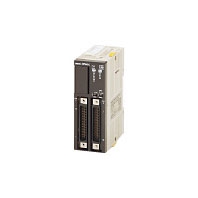
A versatile controller for up to 192 I/O points in an ultra-compact package
Production is expected to close in March 2023.
- Features
- Lineup
- Specifications
- Dimensions
- Catalog / Manual / CAD / Software
last update: February 4, 2014
General
| Item | CPU Unit Specification | ||||||
|---|---|---|---|---|---|---|---|
| CPU Units with
10 I/O points (relay outputs) |
CPU Units with
10 I/O points (transistor outputs) |
CPU Units with
20 I/O points (relay outputs) |
CPU Units with
20 I/O points (transistor outputs) |
CPU Units with
32 I/O points (transistor outputs) |
CPM2C-S CPU Unit
with 10 I/O points (transistor outputs) |
||
| Supply voltage | 24 V DC | ||||||
| Operating voltage range | 20.4 to 26.4 V DC | ||||||
| Power consumption
(Add Expansion Unit consumption from following tables.) |
4 W | 3 W | 4 W | 3 W | 3 W | 3 W | |
| Inrush current | 25 A max. | ||||||
| Insulation resistance | 20 MΩ min. (at 500 V DC) between isolated circuits | ||||||
| Dielectric strength | 2,300 V AC for 1 min (between isolated circuits) | ||||||
| Noise immunity | Conforms to IEC61000-4-4, 2 kV (power lines) | ||||||
| Vibration resistance | Conforming to IEC 60068-2-6, JIS C0040: 10 to 57 Hz, 0.075-mm amplitude, 57 to 150 Hz, acceleration: 9.8 m/s2 in X, Y, and Z directions
for 80 minutes each (Time coefficient; 8 minutes × coefficient factor 10 = total time 80 minutes) |
||||||
| Shock resistance | Conforming to IEC 60068-2-27, JIS C0041: 147 m/s2 three times each in X, Y, and Z directions | ||||||
| Ambient temperature | Operating: 0° to 55°C
Storage: -20° to 75°C (except for the battery) |
||||||
| Humidity | 10% to 90% (with no condensation) | ||||||
| Atmosphere | Must be free from corrosive gas | ||||||
| I/O interface | Terminal block | Connector | Terminal block | Connector | |||
| Power interrupt time | 2 ms min. | ||||||
| Weight | 200 g max. | 200 g max. | 250 g max. | 200 g max. | 200 g max. | 160 g max. | |
| Expansion I/O Unit with 10 I/O points (relay outputs) | 200 g max. | ||||||
| Expansion I/O Unit with 20 I/O points (relay outputs) | 200 g max. | ||||||
| Expansion I/O Units with 24 I/O points (transistor outputs) | 200 g max. | ||||||
| Expansion I/O Unit with 32 I/O points (transistor outputs) | 200 g max. | ||||||
| Expansion I/O Unit with 8 input points | 150 g max. | ||||||
| Expansion I/O Unit with 16 input points | 150 g max. | ||||||
| Expansion I/O Units with 8 output points (transistor outputs) | 150 g max. | ||||||
| Expansion I/O Units with 16 output points (transistor outputs) | 150 g max. | ||||||
| Expansion I/O Unit with 8 output points (relay outputs) | 200 g max. | ||||||
| Simple Communications Unit | 150 g max. | ||||||
| Peripheral/RS232C Adapter Unit | 150 g max. | ||||||
| RS422/RS232C Adapter Unit | 150 g max. | ||||||
| AC Power Supply Unit | 250 g max. | ||||||
| Analog I/O Unit | 200 g max. | ||||||
| Temperature Sensor Unit | 200 g max. | ||||||
| CompoBus/S I/O Link Unit | 150 g max. | ||||||
CPM2C Power Consumption
Use the following power consumption tables to calculate the total power capacity required when using a CPM2C PLC. The rated output for the CPM2C-PA201 AC Power Supply Unit is 15 W. Any surplus power not required for the PLC directly can be used as service power supply for sensors and other devices.
| CPU Unit | Power consumption (W) |
|---|---|
| CPM2C-10C(1)DR-D | 4 |
| CPM2C-20C(1)DR-D | 4 |
| CPM2C-S1[]0C-DRT1 | 3 |
| CPM2C-S1[]0C | 3 |
| CPM2C-10C(1)DT(1)[]-D | 3 |
| CPM2C-20C(1)DT(1)[]-D | 3 |
| CPM2C-32C(1)DT(1)[]-D | 3 |
The power consumption of the CPU Unit includes power for the Programming Consoles and Adapter Units.
Add the following consumptions when using Expansion I/O Units.
| Expansion I/O Unit | Power consumption (W) |
|---|---|
| CPM2C-10EDR | 1 |
| CPM2C-20EDR | 2 |
| CPM2C-24EDT(1)[] | 1 |
| CPM2C-32EDT(1)[] | 1 |
| CPM2C-MAD11 | 3.5 |
| CPM2C-SRT21 | 1 |
| CPM2C-TS001/002 | 1.5 |
| CPM2C-8ED[]/16ED[] | 1 |
| CPM2C-8ER | 2 |
| CPM2C-8ET(1)[]/16ET(1)[] | 1 |
CPM2C Characteristics
| Item | CPU Unit Specification | |||||||
|---|---|---|---|---|---|---|---|---|
| CPU Units with
10 I/O points (relay outputs) |
CPU Units with
10 I/O points transistor outputs) |
CPU Units with
20 I/O points (relay outputs) |
CPU Units with
20 I/O points (transistor outputs) |
CPU Units with
32 I/O points (transistor outputs) |
CPM2C-S CPU Unit with 10 I/O points
(transistor outputs) and CompoBus/S Master function |
|||
| Control method | Stored program method | |||||||
| I/O control method | Cyclic scan with direct output (Immediate refreshing can be performed with IORF(97).) | |||||||
| Programming language | Ladder diagram | |||||||
| Instruction length | 1 step per instruction, 1 to 5 words per instruction | |||||||
| Instructions | Basic instructions: 14
Special instructions:105 instructions, 185 variations |
|||||||
| Execution time | Basic instructions: 0.64 μs (LD instruction)
Special instructions:7.8 μs (MOV instruction) |
|||||||
| Program capacity | 4,096 words | |||||||
| I/O capacity | CPU Unit only | 10 points | 20 points | 32 points | 10 points | |||
| With Expansion
I/O Units |
170 points max. | 180 points max. | 192 points max. | 362 points max. (106 local + 256 remote) | ||||
| Input bits | IR 00000 to IR 00915 (Words not used for input bits can be used for work bits.) | |||||||
| Output bits | IR 01000 to IR 01915 (Words not used for output bits can be used for work bits.) | |||||||
| CompoBus/S input bits | --- | 128 inputs: IR 02000
to IR 02715 |
I/O bits not used for I/
O be used as work bits. |
|||||
| CompoBus/S output bits | --- | 128 outputs:
IR 03000 to IR 03715 |
||||||
| Work bits | 928 bits:IR 02000 to IR 04915 (Words IR 020 to IR 049) and
IR 20000 to IR 22715 (Words IR 200 to IR 227) |
672 bits: IR 02800 to IR 02915 (Words IR
028 to IR 029), IR 03800 to IR 04915 (Words IR 038 to IR 049)and IR 20000 to IR 22715 (Words IR 200 to IR 227 |
||||||
| Special bits (SR area) | 448 bits: SR 22800 to SR 25515 (Words SR 228 to SR 255) | |||||||
| Temporary bits (TR area) | 8 bits (TR0 to TR7) | |||||||
| Holding bits (HR area) | 320 bits: HR 0000 to HR 1915 (Words HR 00 to HR 19) | |||||||
| Auxiliary bits (AR area) | 384 bits: AR 0000 to AR 2315 (Words AR 00 to AR 23) | |||||||
| Link bits (LR area) | 256 bits: LR 0000 to LR 1515 (Words LR 00 to LR 15) | |||||||
| Timers/Counters | 256 timers/counters (TIM/CNT 000 to TIM/CNT 255)
1-ms timers: TMHH(--) 10-ms timers: TIMH(15) 100-ms timers: TIM 1-s/10-s timers: TIML(--) Decrementing counters: CNT Reversible counters: CNTR(12) |
|||||||
| Data memory | Read/Write: 2,048 words (DM 0000 to DM 2047)*
Read-only: 456 words (DM 6144 to DM 6599) PC Setup: 56 words (DM 6600 to DM 6655) *The Error Log is contained in DM 2000 to DM 2021. |
|||||||
| CompoBus/S master functions | --- | --- | Connects to up to 32 slaves with up to 256
I/O link points |
|||||
| DeviceNet slave functions | --- | --- | DeviceNet remote I/O link (DRT model only)
Up to 1,024 I/O link points Explicit messages Read/write of specified areas from PLC with Master Unit |
|||||
| Basic interrupts | Interrupt processing | 2 interrupts | 2 interrupts | 4 interrupts | 4 interrupts | 4 interrupts | 2 interrupts | |
| Shared by the external interrupt inputs (counter mode) and the quick-response inputs. | ||||||||
| Interval timer interrupts | 1 (Scheduled Interrupt Mode or Single Interrupt Mode) | |||||||
| Highspeed
counter |
High-speed
counter |
One high-speed counter: 20 kHz single-phase or 5 kHz two-phase (linear count method)
Counter interrupt: 1 (set value comparison or set-value range comparison) |
||||||
| Highspeed
counter |
Interrupt inputs
(Counter mode) |
2 inputs | 2 inputs | 4 inputs | 4 inputs | 4 inputs | 2 inputs | |
| Shared by the external interrupt inputs and the quick-response inputs. | ||||||||
| Counter interrupts | 2 inputs | 2 inputs | 4 inputs | 4 inputs | 4 inputs | 2 inputs | ||
| Shared by the external interrupt inputs and the quick-response inputs. | ||||||||
| Pulse output | Two points with no acceleration/deceleration, 10 Hz to 10 kHz each, and no direction control.
One point with trapezoid acceleration/deceleration, 10 Hz to 10 kHz, and direction control. Two points with variable duty-ratio outputs (using PWM(--)). (Pulse outputs can be used with transistor outputs only, they cannot be used with relay outputs.) |
|||||||
| Synchronized pulse control | One point:
A pulse output can be created by combining the high-speed counter with pulse outputs and multiplying the frequency of the input pulses from the high-speed counter by a fixed factor. (This output is possible with transistor outputs only, it cannot be used with relay outputs.) |
|||||||
| Quick-response inputs | 2 inputs | 2 inputs | 4 inputs | 4 inputs | 4 inputs | 2 inputs | ||
| Shared by the external interrupt inputs and the interrupt inputs (counter mode).
Min. input pulse width: 50 μs max. |
||||||||
| Input time constant
(ON response time = OFF response time) |
Can be set for all input points.
(1 ms, 2 ms, 3 ms, 5 ms, 10 ms, 20 ms, 40 ms, or 80 ms) |
|||||||
| Clock function | Shows the year, month, day of the week, day, hour, minute, and second. (Battery backup) | |||||||
| Communications functions | Peripheral port:
Supports Host Link, peripheral bus, no-protocol, or Programming Console connections. RS-232C port: Supports Host Link, no-protocol, 1:1 Slave Unit Link, 1:1 Master Unit Link, or 1:1 NT Link connections. A CPM2C-CN111, CS1W-CN114, or CS1W-CN118 Connecting Cable, or an Interface Unit (CPM2C-CIF01-V1 or CPM2C-CIF11) is required to connect to the CPM2C’s communications port. |
|||||||
| Memory protection | HR area, AR area, program contents, read/write DM area contents, and counter values are maintained during power interruptions. | |||||||
| Memory backup | Flash memory:
Program, read-only DM area, and PC Setup Memory backup: The read/write DM area, HR area, AR area, and counter values are backed up. With CPU Units that are equipped with a clock, the battery will backup memory for 2 years at 25°C. With CPU Units that are not equipped with a clock, if a battery is not installed, the internal capacitor will backup memory for 10 days at 25°C. If a battery (optional CPM2C-BAT01 Battery) is installed, it will backup memory for 5 years at 25°C. |
|||||||
| Self-diagnostic functions | CPU Unit failure (watchdog timer), I/O bus error, battery error, and memory failure | |||||||
| Program checks | No END instruction, programming errors (checked when operation is started) | |||||||
CPM2C I/O Specifications
CPU Unit Input Specifications
| Item | Specifications | Circuit configuration | ||
|---|---|---|---|---|
| Units with 10 I/O points | Units with 20 I/O points | Units with 32 I/O points | ||
| Input voltage | 24 V DC +10%/-15% |
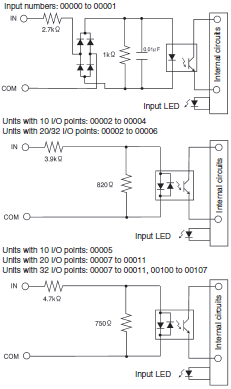 |
||
| Input
impedance |
impedance
IN00000 to IN00001: 2.7 kΩ IN00002 to IN00004: 3.9 kΩ IN00005: 4.7 kΩ |
IN00000 to IN00001:
2.7 kΩ IN00002 to IN00006: 3.9 kΩ IN00007 and up: 4.7 kΩ |
IN00000 to IN00001:
2.7 kΩ IN00002 to IN00006: 3.9 kΩ IN00007: 4.7 kΩ IN00100 to IN00107: 4.7 kΩ |
|
| Input
current |
IN00000 to IN00001:
8 mA IN00002 to IN00004: 6 mA IN00005: 5 mA |
IN00000 to IN00001:
8 mA IN00002 to IN00006: 6 mA IN00007 and up: 5 mA |
IN00000 to IN00001:
8 mA IN00002 to IN00006: 6 mA IN00007: 5 mA IN00100 to IN00107: 5 mA |
|
| ON
voltage/ current |
IN00000 to IN00001:17 V DC min., 5 mA
IN00002 and up:14.4 V DC min., 3.5 mA |
|||
| OFF
voltage/ current |
5.0 V DC max., 1.1 mA | |||
| ON delay | 1 to 80 ms max. Default: 10 ms (See note.) | |||
| OFF
delay |
1 to 80 ms max. Default: 10 ms (See note.) | |||
Note: The input time constant can be set to 1, 2, 3, 5, 10, 20, 40, or 80 ms in the PC Setup.
High-speed Counter Inputs
The following CPU Unit input bits can be used as high-speed counter inputs. The maximum count frequency is 5 kHz in differential phase mode and 20 kHz in the other modes.
| Input | Function | |||
|---|---|---|---|---|
| Differential phase mode | Pulse plus direction input mode | Up/down input mode | Increment mode | |
| IN00000 | A-phase pulse input | Pulse input | Increment pulse input | Increment pulse input |
| IN00001 | B-phase pulse input | Direction input | Decrement pulse input | Normal input |
| IN00002 | Z-phase pulse input or hardware reset input (IN00002 can be used as a normal input when it is not used as a high-speed counter input.) | |||
Interrupt Inputs
CPM2C PCs have inputs that can be used as interrupt inputs (interrupt input mode or counter mode) and quick-response inputs. The minimum pulse width for these inputs is 50 μs.
In CPU Units with 10 I/O points, inputs IN00003 and IN00004 can be used as interrupt inputs. In CPU Units with 20 or 32 I/O points, inputs IN00003 through IN00006 can be used as interrupt inputs.
Expansion I/O Unit Input Specifications
| Item | Specification |
|---|---|
| Input voltage | 24 V DC +10%/-15% |
| Input impedance | 4.7 kΩ |
| Input current | 5 mA |
| ON voltage/current | 14.4 V DC min., 3.5 mA |
| OFF voltage/current | 5.0 V DC max., 1.1 mA |
| ON delay | 1 to 80 ms max. Default: 10 ms (See note.) |
| OFF delay | 1 to 80 ms max. Default: 10 ms (See note.) |
| Circuit configuration |
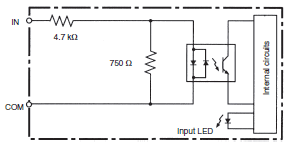 |
Note: The input time constant can be set to 1, 2, 3, 5, 10, 20, 40, or 80 ms in the PC Setup.
CPM2C Output Specifications (CPU Units and Expansion I/O Units)
Relay Output
| Item | Specification |
|---|---|
| Max. switching capacity | 2 A, 250 V AC (cosφ = 1)
2 A, 24 V DC (4 A/common) |
| Min. switching capacity | 10 mA, 5 V DC |
| Service life of relay | Electrical:150,000 operations (24- V DC resistive load)
100,000 operations (240- V AC inductive load, cosφ = 0.4) Mechanical:20,000,000 operations |
| ON delay | 15 ms max. |
| OFF delay | 15 ms max. |
| Circuit configuration |
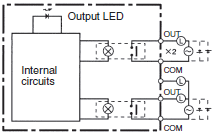 |
Transistor Outputs (Sinking or Sourcing) for CPU Units and Expansion I/O Units
| Item | Specification |
|---|---|
| Max. switching capacity | CPU Units with 10 or 20 I/O Points
01000 to 01007: 40 mA at 4.5 V DC to 300 mA at 20.4 V DC, 300 mA (20.4 to 26.4 V) CPU Units with 32 I/O Points 01000 to 01007: 40 mA at 4.5 V DC to 300 mA at 20.4 V DC, 300 mA (20.4 to 26.4 V) 01100 to 01107: 40 mA at 4.5 V DC to 100 mA at 20.4 V DC, 100 mA (20.4 to 26.4 V) (See note.) Expansion I/O Units 01[]00 to 01[]07: 40 mA at 4.5 V DC to 300 mA at 20.4 V DC, 300 mA (20.4 to 26.4 V) 01[]08 to 01[]15: 40 mA at 4.5 V DC to 100 mA at 20.4 V DC, 100 mA (20.4 to 26.4 V) (See note.) |
| Min. switching capacity | 0.5 mA |
| Max. inrush current | 0.9 A for 10 ms (charging and discharging waveform) |
| Leakage current | 0.1 mA max. |
| Residual voltage | 0.8 V max. |
| ON delay | OUT01000 and OUT01001:20 μs max.
OUT01002 and up:0.1 ms max. |
| OFF delay | OUT01000 and OUT01001:40 μs max. for 4.5 to 26.5 V, 10 to 300 mA
0.1 ms max. for 4.5 to 30 V, 0.5 to 10 mA OUT01002 and up:1 ms max. |
| Fuse | 1 fuse for each 2 outputs (The fuse cannot be replaced by the user.) |
| Circuit configuration |
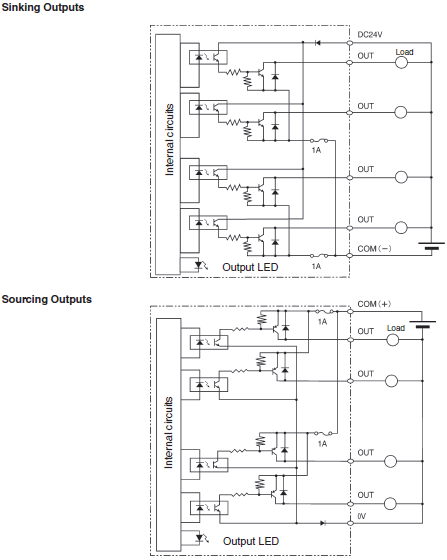 |
Note: Connect dummy resistance as required and maintain the load current between 10 and 150 mA when using
01000 and 01001 for pulse outputs. The ON/OFF response time will increase if the load current is below 10 mA,
preventing outputting high-speed pulses. The transistors will heat if the output current is greater than 150 mA,
possibly destroying the elements.
last update: February 4, 2014

